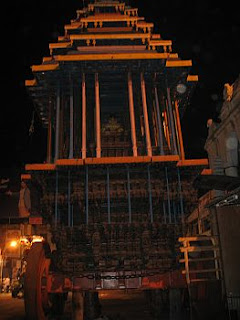This completes the narrative, ‘The Festival of Light,’ by Apeetha Arunagiri. To read the first parts of this narrative go to these links; part one, part two and part three.
“Many are the occasions of inspiration throughout this festival but the outstanding event is the lighting of the Light.
This year I walked with our friend around to the temple dedicated to the feminine aspect Unnamalai lying on the west of Arunachala where the Shakti - the female power point of the hill - peeks up from behind the main protuberance. Unnamalai Temple has a gorgeous stone-pillared Mandapam, or hall, now newly painted and overflowing with pilgrims. And across the road, on the hillside, spreads a newly cleared Rest-a-while Park with a modern iron umbrella above cement benches. The Rest-a-while Park is a perfect viewing place for the lighting of the Light.
Underfoot is conspicuously sordid by this time in the Festival so our walk to the temple had meandered around piles of garbage. We passed a balloon man with his happy crowd of prospective little buyers and the nice clean boys selling ‘Healthy Milk Drinks’ next to the stacked plastic bottles of unhealthy pop shop. Outside Unnamalai a stall selling cheap audiotapes was blotting out existential consciousness entirely yet the ceremonies in the temple were going strong - assisted by other loudspeakers, and the pilgrims were slapping their cheeks and bowing down in obeisance the way they do.
We sat for awhile under a tree near to the shrine next to dear sadhu Ramana in yellow, who spends all his livelong days sweeping the hill round roadway; he had merged with the tree and didn’t look too enthusiastic. Across from me on the hillside sat the irascible sadhu, for once amused, and behind him rose a crassly painted modern iron umbrella sheltering the concrete benches which provide sadhus with such an excellent place to dry their cloths, two sadhus were diligently folding dry their orange dhotis.
As dusk approached we sat down near to the sadhu to wait for the flame to appear. Gradually the Rest-a-while Park’s uncontaminated spaces filled with quiet orderly pilgrims. We had to wait about an hour -- nobody was eating, smoking, talking or drinking. Some had lit incense. For thirty kilometers radius surrounding Arunachala at this time several million people were waiting suspenseful, staring up to the top of the hill, as they always do.
Up on the narrow rocky top of the mountain stands a gigantic copper lamp laboriously carried up that morning by a team of old blokes in loincloths who are traditionally honored with this task. The east face is swarming with humans on their way up with clay pots of ghee to replenish this lamp; a colorful pilgrim snake weaves the traditional path and more adventurous persons scramble up in other directions. The almost top plateau becomes a mini-market, even bangles and balloons can be bought up there, and many will spend the night beside their wares. The very top is standing-room-only of course – for men only; bare feet negotiate the brittle remains of broken clay pots softened by the sticky ghee surface of centuries. Everyone takes up flowers and incense to enhance the honour of presence.
A special ceremony in the Big Temple in town early this morning accompanied a flame-seed from the inner sanctum out into the enormous flagstone courtyard where it first lights another flame-seed set waiting beside another huge copper lamp, before traveling carefully up the path on the east face to the top. There it will be sheltered by the priests in breathless expectation of the rise of the auspicious full moon. Any parts of this ritual which are now left out or compromised by human weakness are just the effects of the degeneration of the times.
The moment our Celestial Orb appears on the eastern horizon the giant lamp on the very top will be lit and the moment the little flame on top appears, the priests in the Big Temple will light the big lamp in the vast courtyard so packed with humans now chanting “Om Namo Sivaya” that if the festival is pelting rain - as it sometimes is - it is surprising how the heat of so many bodies keeps them somewhat warm and dry. The temple elephant also waits with the crowd; this is part of her job. She loves festivals.
The appearance of the light on the top will also signal orchestration of thousands and thousands of small Deepam lamps set waiting outside huts and households as far as eye can see. Many household lamps are mountains of sweet rice-flour, with ghee to carry the flame. After the flame has consumed the ghee, family members share the tasty mountain in tribute to Arunachala. Even dogs get some sometimes.
At the cattle market on the south side of the mountain, thousands of immaculate cattle face the mountain, bells tinkling to the chewing of their cud and the cattlemen squat together in huddles - blankets across scrawny shoulders, by the little bonfires that contribute their own rustic gesture of affection for this wondrous world. Light is eternal.
Very frequently it rains at Deepam. Most of the year it doesn’t rain but at Deepam, it does. This year it is not raining and we are waiting in the Rest-a-while park on the western side of the mountain. The silence deepens towards the golden glow heralding the auspicious first appearance of the flame. Our moon is on its way. A soft golden glow stirs our suspense. Then an irrepressible upsurge of human aspiration arises, it’s palpable: everyone stands up. Loving palms are brought together above uplifted heads while millions and millions of voices carry the stupendous sound “Ahrhoroghorah!” up to the appearance of a tiny little flame.
Ahrhorghorah!
I don’t need to tell you what that means.”





































